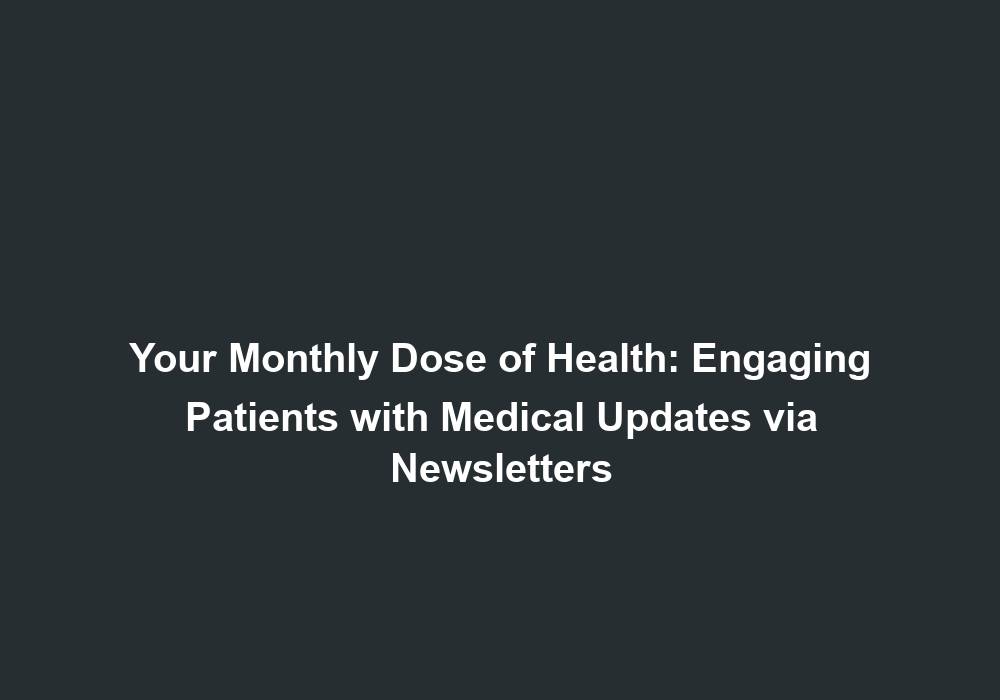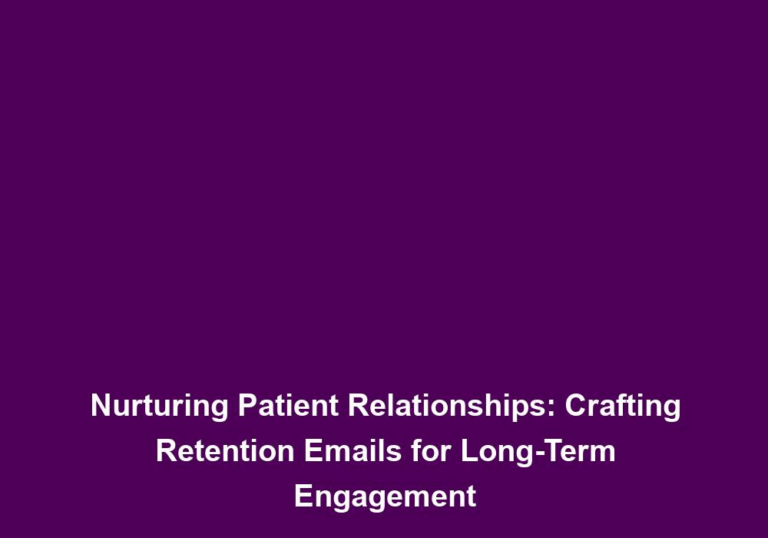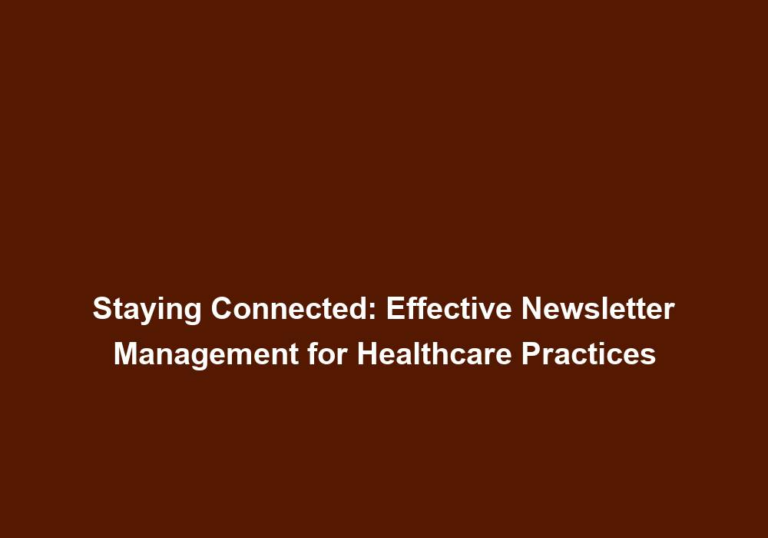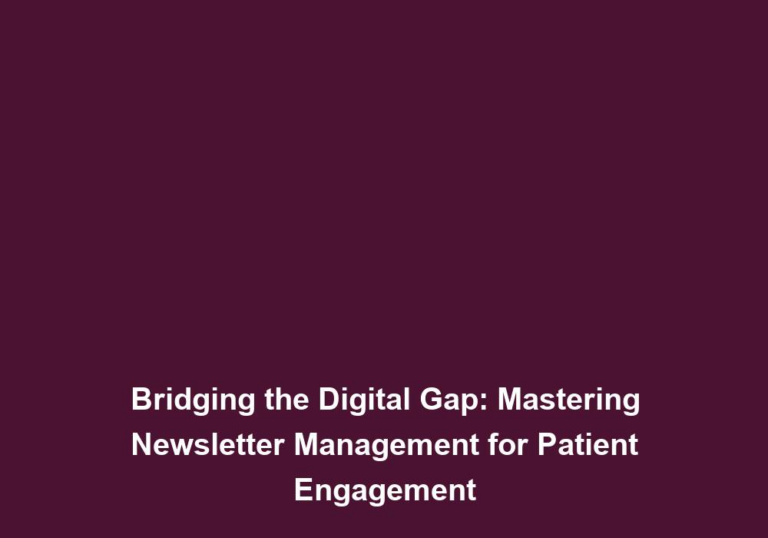Your Monthly Dose of Health: Engaging Patients with Medical Updates via Newsletters
In today’s fast-paced world, staying informed about the latest advancements in healthcare is crucial for patients seeking to maintain and improve their well-being. As a healthcare provider, one effective way to engage and educate your patients is by sending them a monthly newsletter containing valuable medical updates. By providing relevant and insightful information in a concise and accessible format, you can establish yourself as a trusted source of knowledge and foster a strong patient-provider relationship. In this article, we will explore the importance of medical newsletters, discuss key elements to include, and offer tips for creating engaging content.
The Importance of Medical Newsletters
- Promoting Health Awareness: A monthly newsletter allows you to share essential medical information, raise awareness about prevalent health issues, and promote preventive strategies. By addressing common misconceptions and providing evidence-based advice, you can empower your patients to make informed decisions about their health.
- Share the latest research findings and medical breakthroughs related to prevalent health issues.
- Provide tips on how patients can adopt healthy lifestyle habits to prevent diseases.
- Address common misconceptions about certain health conditions and provide accurate information to dispel myths.
- Building Trust and Loyalty: Regularly communicating with your patients through newsletters demonstrates your commitment to their well-being beyond their scheduled appointments. This consistent engagement builds trust, reinforces the patient-provider relationship, and encourages long-term loyalty.
- Share personal stories or testimonials from patients who have had positive experiences with your healthcare services.
- Offer exclusive discounts or promotions for loyal patients to show appreciation for their trust and support.
- Provide updates on your healthcare facility’s achievements, certifications, or community involvement to showcase your commitment to excellence.
- Staying Top of Mind: With busy schedules and numerous distractions, patients may not always remember to schedule appointments or follow up on healthcare advice. By sending a monthly newsletter, you can stay at the forefront of their minds, reminding them of the importance of regular check-ups and providing gentle nudges to prioritize their health.
- Send appointment reminders and encourage patients to schedule regular check-ups.
- Highlight the importance of preventive screenings and vaccinations to maintain optimal health.
- Provide tips for managing common healthcare challenges or conditions that patients may face.
Key Elements of a Medical Newsletter
- Compelling Headlines: A catchy and informative headline is essential to grab the reader’s attention and entice them to explore the newsletter’s content. Focus on using clear language and highlighting the main benefit or takeaway in the headline.
- Example: “Discover the Latest Breakthroughs in Cancer Research: Promising Treatments and Prevention Strategies”
- Example: “Unveiling the Truth About Heart Health: Debunking Myths and Empowering Patients”
- Accurate and Credible Information: Patients rely on healthcare professionals to provide reliable and accurate information. Ensure that the content of your newsletter is based on trustworthy sources, such as peer-reviewed research, reputable medical journals, or expert opinions from recognized authorities in the field.
- Reference scientific studies or research papers to support the information you provide.
- Include quotes or insights from renowned medical experts to add credibility to your content.
- Clearly cite your sources and provide links for patients to access more in-depth information if desired.
- Relevant Topics: Tailor the content of your newsletter to address topics that are relevant to your patients’ interests and needs. Consider common health concerns in your patient population, seasonal health tips, or updates on advancements in specific medical areas.
- Conduct surveys or gather feedback from patients to understand their specific interests and needs.
- Address trending health topics or current events that may impact your patients’ well-being.
- Provide updates on new treatments, medications, or procedures relevant to your patient population.
- Engaging Format: Make your newsletter visually appealing and easy to read by using appropriate headings, subheadings, bullet points, and lists. This formatting breaks up the text and makes it more scannable, allowing readers to quickly find the information they are looking for.
- Use short paragraphs and concise sentences to improve readability.
- Utilize subheadings to organize the content and guide readers through different sections.
- Incorporate bullet points and lists to present information in a clear and structured manner.
- Actionable Advice: Provide practical advice and actionable steps that patients can incorporate into their daily lives. This empowers them to take control of their health and encourages proactive behavior.
- Offer healthy recipes or meal plans that align with patients’ dietary needs or goals.
- Provide exercise routines or fitness tips for different age groups or specific health conditions.
- Share self-care practices or stress management techniques to promote overall well-being.
- Patient Success Stories: Sharing inspiring stories of patients who have achieved positive health outcomes can motivate and encourage others facing similar challenges. Highlighting these success stories humanizes the content and illustrates the real-life impact of medical interventions.
- Interview patients who have experienced significant improvements in their health and share their stories.
- Include before-and-after photos or testimonials to visually showcase the progress made.
- Focus on a variety of health conditions or treatments to cater to a diverse patient audience.
Tips for Creating Engaging Content
- Know Your Audience: Understand the demographics, preferences, and concerns of your patient population. This knowledge will help you create content that resonates with them and addresses their specific needs.
- Conduct patient surveys or analyze patient data to gain insights into their demographics and interests.
- Segment your newsletter subscribers based on age, gender, or medical conditions to personalize the content.
- Monitor engagement metrics, such as open rates and click-through rates, to understand what content resonates the most with your audience.
- Use Plain Language: Avoid using excessive medical jargon or complicated terminology that may confuse or alienate your readers. Instead, strive for clear and concise language that is easily understandable by a wide range of individuals.
- Define medical terms or abbreviations when introducing them in the newsletter.
- Use analogies or everyday examples to explain complex medical concepts in a relatable manner.
- Consider including a glossary or a “Did You Know?” section to educate readers about medical terminology.
- Include Visuals: Incorporate relevant images, infographics, or illustrations to enhance the visual appeal of your newsletter. Visuals can help convey complex information quickly and increase overall engagement.
- Use high-quality images that are related to the content and evoke positive emotions.
- Create infographics to summarize key points or statistics in a visually appealing and easy-to-understand format.
- Include charts or graphs to illustrate trends or comparisons in medical data.
- Encourage Interaction: Include a section in your newsletter that encourages patients to submit questions, share their experiences, or suggest topics for future newsletters. This fosters a sense of community and involvement, making patients feel valued and heard.
- Provide a dedicated email address or an online form for readers to submit their questions or feedback.
- Feature patient stories or testimonials in each newsletter to showcase the impact of community engagement.
- Respond to patient inquiries or suggestions promptly to show that their input is valued.
- Consistency is Key: Establish a regular schedule for sending out newsletters, such as the first Monday of every month. Consistency helps build anticipation and ensures that patients come to expect and look forward to receiving your updates.
- Set up an automated email system to ensure newsletters are sent out on time.
- Plan your content calendar in advance to maintain a consistent flow of valuable information.
- Monitor subscriber engagement and adjust the frequency or timing of newsletters based on their preferences.
By leveraging the power of a monthly newsletter, you can engage your patients, keep them informed about the latest medical updates, and inspire them to prioritize their health. Remember, the primary goal is to provide valuable and relevant content that educates, empowers, and supports your patients on their healthcare journey.







